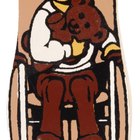
Leisure time refers to time spent doing something we choose to do rather than something we must do. Throughout our lives the amount of leisure time available to us varies depending on our individual responsibilities. But in general, the very young and very old have more leisure time than working-age adults. Even so, work is not the only factor affecting the quantity and quality of our leisure time.
Work

For the average adult, working to earn a living takes up a significant portion of our day, about 7.5 hours on average. When adding in additional tasks, such as commuting, networking and fielding calls and emails, we realize that there really isn't much time left over. It's no surprise then that retired adults over the age of 75 report the most leisure time of any American demographic group, and adults aged 35 to 44 report the least.
Family

Household and child care responsibilities further deduct from our leisure time pursuits. Both men and women report spending two or more hours on household chores daily. This includes activities, such as cleaning, preparing meals, lawn care and other household maintenance chores. Households with children under six years of age estimate an additional two hours daily in child care tasks.
Time Management

Across the spectrum of working Americans, leisure time varies even when circumstances are strikingly similar. Some individuals and families simply manage their time better to accommodate more leisure time. Efficient time managers know how to plan, prioritize and work together to get necessary tasks accomplished. Most importantly, they avoid taking on nonessential tasks by learning to say no to others to get their much-needed leisure time.
Finances

Closely tied to work, finances play a critical role not only in the amount of leisure time we spend, but also in the choice of activities. Even with days off of work, engaging in most leisure activities requires some amount of disposable income. Not surprisingly then, the most popular pastimes also are the cheapest and include TV watching, socializing, reading and using the computer. The number of Americans taking vacations decreases each year.
Related Articles

How to Prepare Quaker Oatmeal

School Uniforms Vs. Regular Clothes

The Disadvantages of Poor Time ...

What Were the Traditional Gender Roles ...

How to Make Your Clothes Not Shrink in ...

What Are the Benefits of Outdoor ...

How Absent Fathers Affect Men

How Many Calories Are in 1 Tablespoon ...

The Average Weight of a Boiled Egg

What Are the Pros and Cons of Volunteer ...

How Much Money Does a Refugee Get from ...

How Much Are Monthly Disability ...

How Does a Parent Going Back to School ...

Do Muslim Women Go to Mosques?

The Role of Collagen & Melanin in Skin

Indiana Child Daycare Laws

The Definition of Non-Cognitive Skills

Preschool Teacher Requirements in ...

How Long to Slow Cook Eye Round Roast ...

How to Put Conditioner in Permanent ...
References
Writer Bio
Based in Cape Coral, Fla., Jennifer Groepl began writing career-related articles in 2010. She also runs her own medical transcription service. Certified in secondary education, Groepl holds a Bachelor of Science in social sciences from Florida State University and a Master of Arts in curriculum and instruction from New Mexico State University.
Photo Credits
Kraig Scarbinsky/Digital Vision/Getty Images